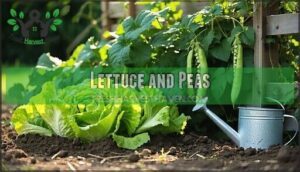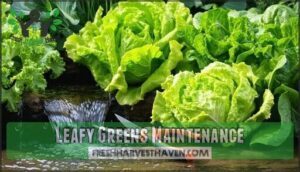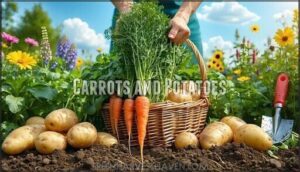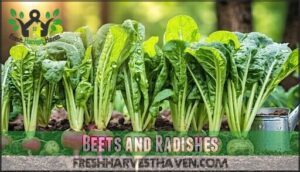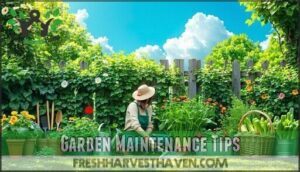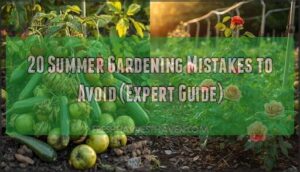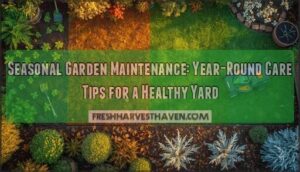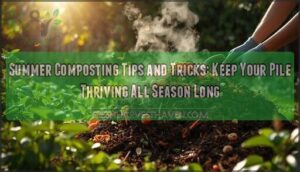This site is supported by our readers. We may earn a commission, at no cost to you, if you purchase through links.
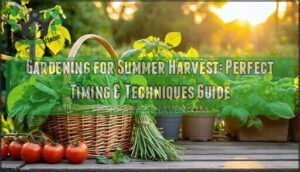
You’ll want to harvest leafy greens like lettuce and spinach in early morning when they’re crisp and cool.
Tomatoes should be picked when they show the first blush of color – they’ll ripen beautifully off the vine.
Root crops like carrots taste sweetest after cool nights, while herbs like basil perform best when harvested before flowering.
Check your plants daily during peak season since vegetables can go from perfect to overripe quickly in summer heat.
The secret lies in knowing each crop’s unique signals for ideal harvest timing and using smart techniques to ensure a successful summer harvest.
Table Of Contents
- Key Takeaways
- Summer Harvest Techniques
- Harvesting Leafy Greens
- Fruit Vegetables Harvest
- Root Crops Harvesting
- Garden Maintenance Tips
- Frequently Asked Questions (FAQs)
- How do you keep a harvest fresh in a summer garden?
- How do you harvest vegetables in summer?
- When is the best time to harvest vegetables?
- When is summer harvest season?
- How do I prepare my garden for summer?
- What’s the key to summer gardening success?
- What is the 70/30 rule in gardening?
- What is the rule of 3 in gardening?
- What do you harvest in summer?
- What is the gardening 3 year rule?
- Conclusion
Key Takeaways
- Harvest early morning when plants are cool and well-hydrated to capture peak flavors and prevent heat stress damage
- Pick regularly and frequently to encourage continuous production throughout the season and prevent vegetables from becoming overripe in summer heat
- Know each crop’s ripeness signals – tomatoes at first blush of color, leafy greens before bolting, and root crops after cool nights for maximum sweetness
- Use clean, sharp tools and handle produce gently to prevent plant damage and maintain harvest quality while extending your garden’s productive season
Summer Harvest Techniques
Summer harvest success depends on timing and technique to capture peak flavors and maximum yields.
You’ll need to recognize ripeness signs and use proper harvesting methods to keep your garden producing throughout the growing season.
General Harvesting Tips
Summer harvest success starts with mastering harvest timing and proper harvesting techniques.
Sharp harvest tools and consistent crop monitoring guarantee peak garden yields while protecting your plants from damage.
The right tools and timing turn garden chaos into harvest success.
- Harvest early morning when sugar content and hydration levels peak
- Use clean, sharp tools like scissors or pruners to prevent plant injury
- Pick regularly to encourage continued production throughout the season
- Monitor ripeness signs including color changes, firmness, and aroma for ideal fruit ripening
Understanding proper garden care is essential for a successful summer harvest.
Crop-Specific Guidelines
Each crop demands different harvesting techniques for maximum yield.
Summer squash needs daily checks—harvest when tender and small. Green beans should be picked young and frequently to keep plants producing. Okra pods mature quickly from bottom up, requiring daily clipping at 2-4 inches.
| Crop | Harvest Size/Timing | Frequency |
|---|---|---|
| Summer Squash | Small, tender (6-8 inches) | Daily checks |
| Green Beans | Young pods, before seeds bulge | Every 2-3 days |
| Okra Pods | 2-4 inches long | Daily harvest |
| Tomatoes | Full size, slight give when pressed | As they ripen |
Timing for Peak Ripeness
Understanding when your vegetables reach peak ripeness transforms your summer harvest from guesswork into precise timing.
Early morning harvesting captures maximum sweetness and moisture content in most crops.
Catch vegetables at their flavor peak with perfect morning timing.
Mastering the ripe vegetable signs is essential for a successful harvest.
- Watermelons display creamy yellow undersides and sound hollow when tapped
- Tomatoes yield slightly to gentle pressure while showing full color development
- Zucchini maintains shiny skin at 6-8 inches before becoming tough and seedy
- Peppers develop firm, glossy skin at 2-4 inch diameter for ideal flavor
Harvesting Leafy Greens
Leafy greens need careful timing and technique to maintain their tender texture and fresh flavor.
You’ll want to harvest these crops in the early morning when they’re well-hydrated and at their peak quality.
Lettuce and Peas
Harvesting lettuce and peas requires perfect timing for maximum flavor.
Pick lettuce leaves when they’re crisp and full-sized but before bolting occurs. For pea varieties, harvest pods when they’re plump but still tender.
Cool-season vegetables like these prefer morning harvesting when temperatures are lower.
Proper soil preparation and seed starting timing guarantee continuous harvests throughout early summer gardening seasons.
Herbs Like Basil and Mint
When basil reaches 6-8 inches tall, trim stems above leaf nodes to encourage bushier growth and prevent flowering.
Harvest mint before blooms appear by cutting the top 4-8 inches above leaf pairs. Both herbs yield best when picked in morning after dew dries.
Regular herb pruning every 2-3 weeks maximizes your leafy harvest throughout summer. Understanding optimal harvesting techniques is essential for maintaining healthy plants and promoting continuous growth.
Leafy Greens Maintenance
Keep your leafy greens thriving with smart leaf care techniques.
Regular green pruning encourages continuous harvest throughout summer.
Monitor harvest timing by checking outer leaves first – they’re ready when firm and full-sized.
Water management matters: consistent moisture prevents bitter flavors.
Good soil quality supports steady growth.
Pick frequently to maintain productive leafy vegetables and extend your garden maintenance season, ensuring continuous harvest throughout the year.
Fruit Vegetables Harvest
Fruit vegetables reach peak flavor when harvested at the right moment, making timing your most valuable garden tool.
You’ll transform ordinary summer crops into kitchen treasures by watching for specific ripeness cues and using proper harvesting techniques, which involves understanding the right moment to make the most of your garden.
Tomatoes and Peppers
During peak ripening months, tomatoes and peppers transform from garden novelties into serious harvest powerhouses. Your tomato care routine determines success—harvest when fruits reach the "breaker stage" for ideal ripening.
Meanwhile, pepper varieties offer flexibility in harvest timing. Key harvest timing strategies:
- Pick tomatoes at 50% green, 50% pink coloration
- Harvest bell peppers when glossy and 3-7 inches long
- Collect hot peppers at full color for maximum heat
Check plants daily during summer gardening season. Frequent picking encourages continued fruit production while preventing garden pests from claiming your bounty. Use clean shears for vegetable gardening success.
Cucumbers and Melons
Clip cucumbers when they’re large enough to use, checking daily for ideal tenderness.
Remove overripe fruit to encourage continued production.
For melons, judge ripeness by rapping the surface and observing skin color changes.
Withhold water a week before harvest to concentrate flavors.
Implement vine training and fruit thinning for better yields.
Understanding proper harvesting ripe cucumbers techniques is vital for maximizing crop quality and yield.
Eggplant and Okra
Throughout your summer harvest, eggplant and okra demand different approaches for peak production.
These heat-loving vegetables thrive in warm conditions but require specific eggplant care techniques and timing strategies.
- Eggplant harvest: Snip glossy fruits when growth stops – dull skin indicates overripeness
- Okra collection: Clip tender 2-4 inch pods daily from bottom up for continuous production
- Summer maintenance: Regular harvesting encourages new growth and prevents tough, woody vegetables
Root Crops Harvesting
Root vegetables offer some of summer’s most rewarding harvests, requiring specific timing and techniques for maximum results.
You’ll need to understand each crop’s unique signals and soil conditions to maximize your root vegetable yields.
Carrots and Potatoes
Begin harvesting carrots when they’re large enough to use. Different carrot varieties mature at various rates throughout summer.
Water the soil before lifting to soften ground and protect tender skin. For potatoes, harvest when plants die back naturally.
New potatoes can be lifted earlier for tender treats. Proper harvest timing prevents potato diseases and helps maintain good root crop storage quality.
To achieve maximum yields, understanding root harvesting methods is vital for gardeners to master root harvesting methods.
Sweet Potatoes and Onions
Two powerhouse root crops demand different summer harvest strategies.
Sweet potatoes reach maturity after 85-120 days when leaves turn yellow-bronze and tubers bulge soil surfaces.
Onion harvesting begins when 50-80% of tops fall over with soft, pliable necks.
Both require gentle garden fork loosening and dry weather conditions.
Sweet potato care includes cutting vines before digging, while onion harvesting means grasping bulbs directly, not leaves, for proper summer bulbing success.
Beets and Radishes
Radishes reach maturity in just 30 days from summer sowing, making them perfect for quick satisfaction.
Harvest when roots are firm and marble-sized for crisp radish recipes.
Beets need 60-90 days but reward patience with superior beet nutrition.
Both root vegetables prefer consistent moisture and loose soil.
Pull radishes promptly to prevent woody texture, and remember that harvest timing matters for peak flavor in your summer harvest.
Garden Maintenance Tips
Successful summer gardening extends beyond harvesting into maintaining healthy plants throughout the growing season.
You’ll need effective watering techniques, pest control strategies, and proper fencing to protect your crops from both environmental stress and unwanted visitors.
Watering and Mulching
Smart watering and mulching strategies reveal your garden’s potential during challenging summer months.
Deep morning irrigation builds drought resilience while organic mulch creates a protective barrier that conserves precious soil moisture. Effective use of drip irrigation systems can substantially enhance water conservation efforts.
- Water Conservation: Apply 1-2 inches weekly through drip irrigation systems rather than frequent shallow watering
- Mulch Types: Use grass clippings, straw, or shredded leaves to reduce evaporation by 70%
- Drought Management: Raise mower height and mulch around drought-tolerant crops for maximum protection
Pest Management Strategies
Effective pest management strategies protect your summer harvest without harsh chemicals.
Use organic pest control methods like beneficial insects – ladybugs devour aphids while parasitic wasps target caterpillars. Apply natural repellents such as neem oil or garlic spray for eco-friendly solutions.
Biological methods include companion planting with marigolds to attract pest predators. Physical barriers like row covers exclude harmful insects while preserving beneficial ones.
For best results, consider using a neem oil spray as part of your integrated pest management approach to achieve eco-friendly solutions and protect your harvest with beneficial insects.
Fencing for Crop Protection
Reliable fencing protects your summer harvest from wildlife damage.
Install deer fencing at least 3 meters high with buried netting extending 30 centimeters underground. For rabbit guards, use 1.25-meter barriers with mesh bottoms.
Garden borders need sturdy posts every 2 meters. Wildlife deterrents work best when combined with proper crop barriers and secure garden gates for complete protection.
Effective deer fencing solutions can prevent significant crop loss and damage. Deer fencing and wildlife deterrents are crucial for protecting your harvest.
Frequently Asked Questions (FAQs)
How do you keep a harvest fresh in a summer garden?
Time’s ticking as summer heat threatens your fresh bounty.
Harvest early morning when plants are cool and hydrated.
Cut produce with clean tools, handle gently to avoid bruising, and get everything into cool storage immediately to lock in peak flavor and nutrients.
How do you harvest vegetables in summer?
Pick vegetables early morning when they’re cool and hydrated.
Use scissors or knives to avoid plant damage.
Harvest regularly to encourage production.
Check for ripeness signs like color changes, firmness, and aroma before cutting to ensure you pick the vegetables at the right time, considering factors like firmness.
When is the best time to harvest vegetables?
Like checking your car’s gas gauge before hitting empty, you’ll harvest vegetables at their peak ripeness.
Pick early morning when plants are well-hydrated.
Look for color changes, proper firmness, and sweet aromas signaling prime flavor.
When is summer harvest season?
Summer harvest season typically runs from late June through early September, depending on your planting zone.
You’ll enjoy peak production during this warm period when most crops reach maturity and deliver superior flavors.
How do I prepare my garden for summer?
Clean garden beds, amend soil with compost, install reliable fencing, set up deep watering systems, and plant summer crops.
Mulch heavily to retain moisture and suppress weeds for ideal growing conditions.
What’s the key to summer gardening success?
Though constant watering seems logical, you’ll master summer gardening by timing harvests correctly, mulching deeply, and watering early morning. Regular picking encourages production while preventing plant stress.
What is the 70/30 rule in gardening?
You’ll work with the 70/30 rule to balance structure plants (70%) with seasonal fillers (30%) for garden success. Structure plants bring visual interest until autumn while filler plants provide foliage color.
What is the rule of 3 in gardening?
The rule of three involves planting in odd numbers to create natural, flowing garden spaces that look more visually balanced.
You’ll group plants in threes, fives, or sevens since odd numbers appear more natural to the eye.
What do you harvest in summer?
You’ll harvest tomatoes, cucumbers, beans, peppers, corn, summer squash, zucchini, eggplant, okra, melons, berries, herbs, potatoes, carrots, and leafy greens during summer’s productive months.
What is the gardening 3 year rule?
Like splitting dinner with friends, crop rotation divides your garden into three sections.
Don’t plant crops from the same family in the same spot more than once every 3-4 years.
This breaks pest cycles and prevents soil nutrient depletion naturally.
Conclusion
Success breeds success – gardening for summer harvest becomes effortless once you master these timing techniques.
You’ve learned when cool mornings favor leafy greens and how tomatoes ripen perfectly off-vine.
Root vegetables reward patience with sweetness after cool nights.
Daily monitoring prevents overripeness in summer heat.
Your garden will thrive when you apply these proven harvesting methods consistently throughout the growing season.
- https://www.gardenary.com/blog/the-ultimate-guide-to-summer-gardening
- https://www.clickorlando.com/weather/2025/04/10/how-to-have-a-successful-spring-garden-for-a-summer-harvest/
- https://www.organicauthority.com/live-grow/summer-organic-gardening-to-dos
- https://www.usda.gov/about-usda/news/blog/tips-starting-organic-garden
- https://www.gardendesign.com/vegetables/summer.html

